How Do You Polish Cement? A Complete Step-by-Step Guide
Posted On May 24, 2025
Key Takeaways
- Cement polishing transforms plain concrete into a smooth, durable, and visually appealing surface.
- The process involves grinding, honing, and polishing using specialized tools and materials.
- Polished cement floors are popular for both residential and commercial applications due to their low maintenance and modern look.
- Factors such as surface condition, desired finish, and whether the cement is new or old influence the polishing approach.
- Proper surface preparation and the right equipment are essential for achieving a consistent and lasting polish.
Introduction: Why Polish Cement?
Cement polishing is a process used to refine and enhance concrete surfaces. It improves both the look and performance of cement floors by increasing shine, smoothness, and durability. Whether in a home, warehouse, retail store, or office, polished cement delivers a sleek, modern appearance while also being practical.
Polishing cement is more than just making it look shiny. It involves mechanically grinding and smoothing the surface with abrasives until the desired level of gloss is achieved. This process also strengthens the cement, reduces dust, and makes the surface easier to clean.
Understanding the Basics: What Is Polished Cement?
Polished cement—often referred to as polished concrete—is a finished flooring system that is mechanically ground and polished using abrasive tools. During the process, a chemical hardener known as a densifier is applied to help solidify the surface and improve its resistance to wear.
Polished cement can have varying levels of sheen, from matte to high-gloss, depending on how fine the polishing grit is. This makes it customizable for different aesthetic preferences and functional needs.
Polished cement is commonly used in:
- Homes (especially basements, kitchens, and living rooms)
- Commercial spaces (retail, showrooms, restaurants)
- Industrial environments (warehouses, garages)
Tools and Materials Required
Before starting, it’s important to gather the right tools and materials. Here’s a list of what you’ll typically need:
- Concrete grinder (walk-behind or handheld)
- Diamond grinding pads (in various grits)
- Chemical concrete densifier
- Polishing pads (resin-based)
- Vacuum (wet/dry with HEPA filtration)
- Water (for wet polishing) or dust containment system (for dry polishing)
- Edge polishing tools (optional, for corners and tight spaces)
- Sealer or stain guard (optional, for added protection)
Each of these components plays a specific role in the grinding and polishing process. Using the right combination ensures a smooth, even, and durable finish.
Step-by-Step Process: How to Polish Cement
1. Evaluate the Surface
Start by checking the condition of the cement surface. Is it newly poured, or aged and cracked? Is there existing paint, glue, or coating? The answers to these questions help determine the level of surface preparation needed.
Surface evaluation also includes checking for high and low spots, uneven edges, or soft patches. These will impact how much grinding is necessary.
2. Surface Preparation
Remove all debris, dirt, paint, or adhesives from the surface. If the concrete has large cracks or holes, patch them with a cement-based repair compound and allow it to cure.
For heavily contaminated or coated surfaces, a coarse-grit metal bond diamond pad may be required to remove surface layers before starting the polishing process.
Proper preparation sets the foundation for a uniform finish. Skipping this step can lead to inconsistent results or poor adhesion of densifiers and sealers.
3. Start Grinding
Begin the grinding process with a low-grit metal bond diamond pad—typically between 30 and 50 grit. This step removes surface imperfections and levels the floor. Work methodically in sections, overlapping each pass to avoid missed areas.
Depending on the surface and finish goals, multiple passes at increasing grit levels will be required. After initial grinding, move on to medium-grit pads (80–150 grit), which start refining the texture and closing up pores.
At this stage, you may notice a smoother and more uniform look developing.
4. Apply Densifier
Once the surface is level and has been ground with medium-grit pads, apply a concrete densifier. This chemical treatment penetrates into the cement and reacts with calcium hydroxide to form a harder, denser surface.
Allow the densifier to soak in as directed by the manufacturer—usually between 30 minutes to a few hours. Some densifiers also help prevent dusting and enhance stain resistance.
Once cured, continue to the polishing phase.
5. Begin Polishing
Switch to resin-bond polishing pads, starting with a 200-grit and moving through higher grits (400, 800, 1500, and optionally 3000) depending on the desired sheen level.
Each pass should further refine the surface and enhance the gloss. Wet or dry polishing can be used, though dry polishing is often favored for indoor projects due to faster cleanup and less water usage.
Wet polishing, however, can reduce dust and cool down the surface, which may be beneficial in large-scale or high-traffic environments.
6. Edge and Corner Finishing
Use smaller hand tools or edge grinders to reach areas the main machine cannot access. These areas include corners, along walls, and under fixtures.
It’s important not to neglect these sections, as inconsistent polishing in corners can detract from the finished appearance.
7. Optional Sealing or Stain Guard Application
While densified and polished concrete is inherently durable, adding a concrete sealer or stain guard can increase resistance to moisture, oil, and other contaminants.
Sealants are especially useful in kitchens, bathrooms, and commercial areas where spills are more likely. They also help maintain shine and simplify cleaning routines.
Apply the sealer evenly with a mop or sprayer and let it dry fully before using the space.
Polishing New vs. Existing Cement
Polishing cement isn’t limited to new installations. In fact, many existing floors can be polished, provided they’re structurally sound.
- New cement floors should cure for at least 28 days before polishing.
- Older cement floors may need additional repair work or deeper grinding to remove worn or damaged layers.
With the right equipment and surface preparation, both types of cement can achieve similar aesthetic and performance results.
Benefits of Polished Cement
Polished cement offers several practical and design-related advantages:
- Low Maintenance: Requires minimal upkeep and no waxing.
- Durable: Resistant to impact, abrasion, and foot traffic.
- Clean Appearance: Smooth and stain-resistant.
- Sustainable: Long lifespan and no need for additional floor coverings.
- Cost-Effective: Lower lifecycle cost compared to tile or carpet.
- Aesthetic Flexibility: Ranges from matte to high-gloss finishes.
These benefits make polished cement a suitable option for both utility and style.
Common Mistakes to Avoid
- Rushing the process: Skipping grit levels can leave visible scratches or reduce gloss.
- Inconsistent pad usage: Uneven pressure can result in swirl marks.
- Neglecting edge areas: Leaving corners unpolished can make the finish look incomplete.
- Skipping densifier: This step is essential for strength and longevity.
- Poor surface prep: Failing to clean or repair the base slab can cause problems later on.
Taking the time to follow each step carefully helps ensure the best possible result.
Conclusion
Polishing cement is a practical way to enhance a concrete surface, offering both functional improvements and a refined look. Whether you’re upgrading a garage floor, refreshing a commercial space, or finishing a modern interior, understanding how to polish cement properly can help you achieve long-lasting, attractive results. By using the right tools, following a structured process, and applying quality materials like densifiers and sealers, polished cement becomes a durable and attractive flooring choice for nearly any environment.
One Awesome Concrete Serving the Craven Village Community and Beyond in Houston
One Awesome Concrete is dedicated to serving the diverse needs of the local community of Houston, including individuals residing in neighborhoods like Craven Village. With its convenient location near landmarks such as the Buffalo Run Park and major intersections like Buffalo Run and S Cravens Rd (coordinates:29.614340870757424, -95.51713681474216), we offer Polished cement contractors Houston services.
Get Polished Cement Contractors Houston Services at Craven Village Now
Contact Us
(832) 368-9257
Navigate from Craven Village to One Awesome Concrete Now
5 FREQUENTLY ASKED QUESTIONS (FAQs)
- What does it mean to polish cement?
Polishing cement involves mechanically grinding and smoothing the surface of concrete to create a sleek, glossy, and durable finish. The process uses diamond abrasives and may include applying a densifier for added strength. - Can any cement floor be polished?
Most structurally sound cement floors can be polished, whether new or existing. However, surfaces with major cracks, moisture issues, or soft patches may need repair before polishing. - What tools are needed to polish cement?
To polish cement, you typically need a concrete grinder, diamond grinding pads, polishing pads, a densifier, a wet/dry vacuum, and optional sealants. Edge tools may also be used for corners and tight areas. - How long does it take to polish a cement floor?
The time varies depending on the size of the area and the condition of the surface, but most residential floors can be polished within 1 to 3 days, including prep and curing time for any chemical treatments. - Do I need to seal polished cement?
Sealing is optional but recommended for areas exposed to moisture, spills, or high traffic. A quality sealer can enhance stain resistance and prolong the floor’s appearance and performance.
RELIABLE, TRUSTWORTHY, and AFFORDABLE PROFESSIONAL SERVICES
or Call us now at
(832) 368 – 9257
Recent Blogs

EXPERT CONSULTATION, SWIFT QUOTATIONS
Ready to bring your concrete vision to life? Reach out to One Awesome Concrete Polishing & Staining today for expert consultations and fast, accurate quotations. Our team of professionals is dedicated to providing personalized guidance and precise estimates, ensuring that your project is executed to perfection. Whether you’re looking to enhance your home, renovate a commercial space, or overhaul an industrial facility, we have the experience and tools to handle projects of all sizes. Contact us today, and let’s work together to transform your space with the beauty and durability of cement polishing company Houston. Experience top-tier service and exceptional results with One Awesome Concrete Polishing & Staining.


























